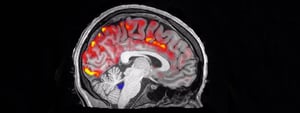For the first time a team of neuroradiologists and bioengineers from Boston University (USA) managed to “film” a phenomenon that occurs when we sleep, which to date was unknown: the movement (or rather a true and proper series of rhythmic waves) of cerebrospinal fluid, namely the thin layer of fluid that usually surrounds the brain and spinal cord that acts as a barrier against shock. The US researchers discovered that these rhythmic waves start as soon as we fall asleep, and probably get rid of waste and toxic proteins, which shouldn’t accumulate: in other words, they actually brainwash us…The results of the research were published in the journal Science. A short video made by Laura Lewis, can also be found here.
The researchers showed that cerebrospinal fluid waves are created in sync with slow brain waves (produced by neurons, when we fall asleep) and the flow of blood, which tends to drain from the brain while we sleep, because when we do, we do not need as much oxygen (which is transported by our blood). The researchers believe that when pressure in the brain falls, due to the draining of blood, the cerebrospinal fluid probably flows more quickly (generating the waves) in order to replace part of the missing blood and to keep the situation at a safe level.
The neuroradiologists identified the waves by studying 13 people aged between 23 and 33, who were subjected to magnetic resonance imaging and an electroencephalogram while they slept. Despite the many difficulties experienced by the 13 volunteers due to the fact that it was not easy to fall asleep with their heads covered in electrodes, the results were clear from the scans: a few minutes after falling asleep this sort of current was always created, which – as we said – appears to be coordinated with blood flow and brain activity.
There are still many aspects to be understood, starting with the physiological role of this kind of washing. What happens to the elderly, or patients affected by neurodegenerative disorders, such as Alzheimer’s, which often causes sleep disturbances and a lower “production” of slow brain waves, also needs to be explored. When the picture is clearer, it will be possible to check, for example, if the measurement of the flow of cerebrospinal fluid can be an indicator of a person’s state of health and brain function, and if it will be possible to intervene in order to fix irregular flows.

